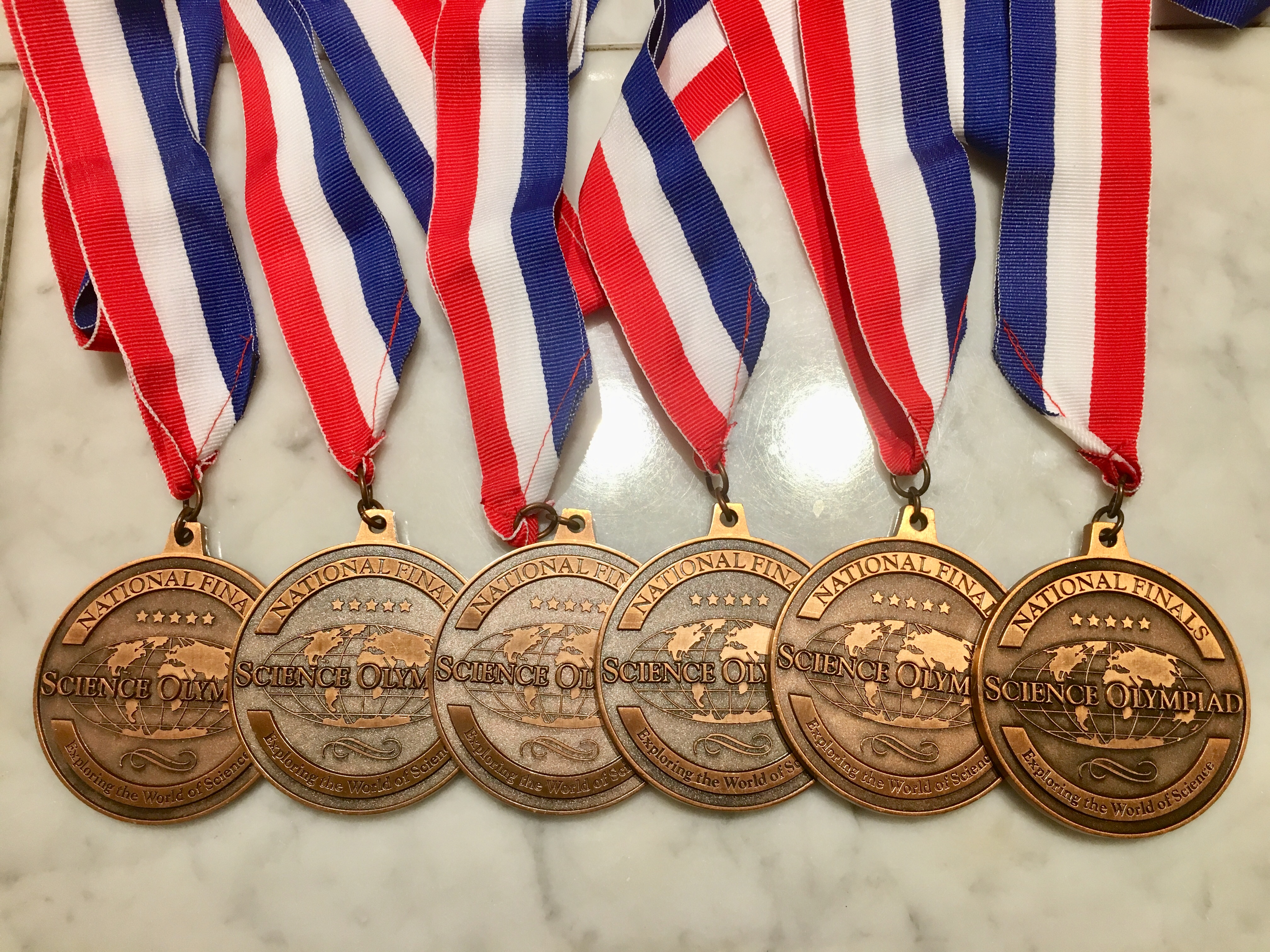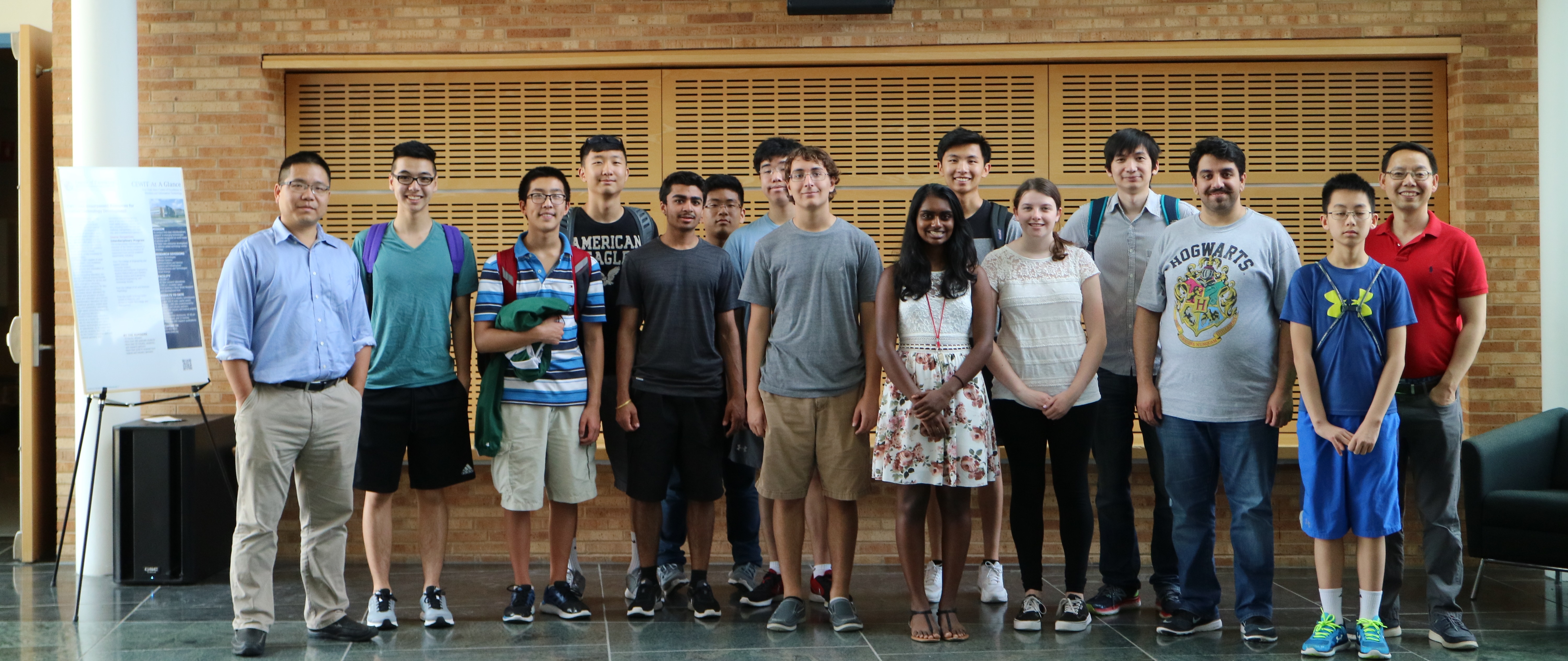
My 6 SciO Nationals medals
Science Olympiad is a nation-wide science competition where out of a team of 15, students work in groups of 2 or 3 in individual events, which each cover a specific science topic. These topics are tested on in depth, and most cover college-level content. Some events include astronomy, microbiology, projectile/fluid physics, and anatomy and physiology. The score each event earns is the place the pair/group get in the event relative to all other competitors. The teams with the overall lowest scores move on to the next highest level of tournament. There are regional, state, and national level tournaments, as well as a few invitational (but still very competitive) tournaments that are used for practice. While regional tournaments do not need qualification, state and national tournaments require a specific team placement at the lower level tournament to qualify. For example, to qualify for the NYS tournament, a team needs to place 1st to 6th place at the regional level out of 35-40 teams who compete in the tournament. These tournaments are extremely competitive, as each tournament's questions become progressively more difficult as the tournament's level increases, and the average team's skill becomes increasingly higher. In addition, the number of teams remains high, with Regionals having ~40 teams, States having 40-50 teams, and Nationals having 60+ teams.
As a junior high student, our A team has made the national-level tournament every year. I qualified onto the school's Science Olympiad A team in 8th and 9th grade, and I got a medal in almost every event at every tournament.
In 8th grade, I competed in Fossils, which focused on geology pertaining to the fossil record; Scrambler, which was a building event focused on building a device to launch a wheeled vehicle a specified distance; and Reach for the Stars, which focused on identifying constellations and understanding information about various astronomical objects. Places at each level tournament are on the appropriate table. As a team, we placed 10th overall at Nationals.
I was also the treasurer of the Science Olympiad A Team in 8th grade, and was responsible for dealing with all finances, including hotels for tournaments, tournament registration, and reimbursements for practice materials.
| Events Tournament |
Fossils | Reach for the Stars | Scrambler |
|---|---|---|---|
| Regional | 1st | 1st | 1st |
| State | 1st | 1st | 2nd |
| National | 3rd | 3rd | 5th |
| Events Tournament |
Hovercraft | Microbe Mission | Reach for the Stars | Anatomy and Physiology |
|---|---|---|---|---|
| Regional | 1st | 3rd | 1st | 2nd |
| State | 3rd | 2nd | 2nd | 4th |
| National | 3rd | 4th | 6th | 24th |
In 9th grade, I competed in Anatomy and Physiology, which centered around the human body and various different body systems (with a focus on Nervous, Endocrine and Sense Organs); Hovercraft, which focused on fluid and projectile physics as well as on building a small device that could hover above the ground and travel a certain speed; Microbe Mission, which tested knowledge of microbiology and microscopy; and Reach for the Stars. Places at each level tournament are on the appropriate table. As a team in 9th grade, we placed 10th at Nationals.
I was also the captain of the Science Olympiad A Team in 9th grade, and I was tasked with motivating the team, making sure the team members were working, and overseeing the jobs of the other board members.
As a high school student, it is much more uncertain whether or not we will make the national tournament. High school Science Olympiad (divison C) is singificantly more competitive than junior high (division B). I qualified for our high school's Science Olympiad A team in 11th grade, but still competed in 10th grade, just not as a team member at States (I competed as a trial event competitor, and we didn't make Nationals that year).
In 10th grade, I competed in Hovercraft; Anatomy and Physiology (with the focus being the Immune, Digestive and Respiratory systems); Astronomy (with a focus on Stellar Evolution and Type II Supernovae); and Thermodynamics, which covers the chemistry and physics aspects of thermodynamics, as well as building a predictable and effective thermal insulator. Places at each level tournament are on the appropriate table. As a team in 10th grade, we placed 3rd at States, and thus didn't qualify for Nationals.
| Events Tournament |
Hovercraft | Astronomy | Thermodynamics | Anatomy and Physiology | Parasitology (State Trial) |
|---|---|---|---|---|---|
| MIT Invitational | 7th | 21th | 61st | 24th | Didn't Compete |
| Regional | 2nd | 3rd | 2nd | 2nd | Didn't Compete |
| State (as an alternate) | Didn't Compete | Didn't Compete | Didn't Compete | Didn't Compete | 1st |
| Events Tournament |
Fossils | Astronomy | Circuit Lab | What the Function (MIT Trial) |
|---|---|---|---|---|
| MIT Invitational | 4th | 9th | 8th | 5th |
| Cornell Invitational | 1st | 6th | 11th | Didn't Compete |
| State | 1st | 2nd | 37th | Didn't Compete |
| National | 14th | 16th | 22nd | Didn't Compete |
In 11th grade, I competed in Fossils; Astronomy (with a focus on Stellar Evolution and Starburst Galaxies); Circuit Lab, which focuses on the mechanisms and physics of circuits, electricity and magnetism; and Code Busters at the MIT Invitational, which covers the chemistry and physics aspects of thermodynamics, as well as building a predictable and effective thermal insulator. Places at each level tournament are on the appropriate table. As a team in 11th grade, we placed 2nd at States, qualifying for Nationals as a school for the first time in 3 years. We then placed 18th at Nationals.
My 6 SciO Nationals medals
My 6 SciO Nationals medals
My 6 SciO Nationals medals
My 6 SciO Nationals medals
The DuPont Essay contest was a competition sponsored by the company DuPont. It was a competition where students all over the nation would submit 750-1000 word essays that discussed a particular science topic and proposed a solution to an existing scientific issue. There were 2 divisions, with one consisting of high school students and the other consisting of middle school students. There were 3 major awards given (1st to 3rd), as well as approximately 30 honorable mentions.
As an 8th grade student, I competed in this essay contest, and I won an honorable mention, of which only one student had won from my school prior.

My DuPont Essay Contest Honorable Mention certificate
I have participated in Science Research each summer since the summer after 9th grade, with different topics each summer. All my projects involved some amount of code.
In the summer of 9th grade, I qualified for the Computer Science and Informatics Summer Research Experience (CSIRE) Program at Stony Brook University in its pilot year. Through that program, I worked under Dr. Daifeng Wang on a project about Lung Adenocarcinoma gene expression across different stages. The aim was to find a set of genes that, through a change in expression, would indicate what stage a specific type of lung cancer was, without having to image the body. Data was taken from The Cancer Genome Atlas (TCGA).

Me with the other CSIRE 2018 students and faculty
In the summer of 10th grade, I contacted Dr. Jingfang Ju, who allowed me to do research at his lab. This research pertained to microRNA, specifically miR-194-5p, and what targets it had in pancreatic cancer patients specifically. miR-194-5p appearance had been associated with other cancers, but its role in pancreatic cancer had yet to be researched thoroughly. I correlated gene expression with miR-194-5p expression from patients with pancreatic adenocarcinoma (TCGA-PAAD) to give a list of predicted targets, along with their Pearson correlation coefficient. The predicted targets, along with their correlation score, were cross-referenced with a few different target prediction software's target predictions.
In the summer of 11th grade, I contacted Dr. Shaoyu Ge, who allowed me to do research at his lab. This research pertained to lipid droplets and how they changed in the aging brain. Images were taken from mice brains of different ages, all stained with Perilipin 1, which targets lipid droplets and thus allows us to see them. I then analyzed lipid droplet number and distribution across ages using a program I wrote.